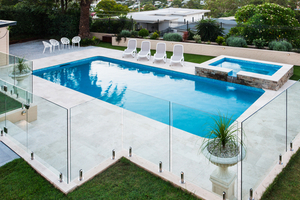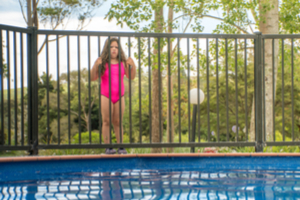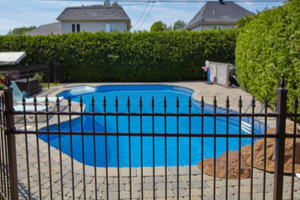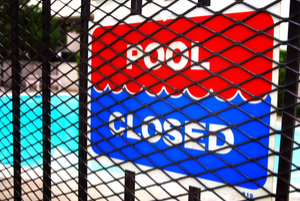So, the Australian heat finally got to you – and the brand-new pool in your backyard is almost complete. There’s just one thing missing though, and that’s the perfect fence. Not only do they prevent drowning and injuries amongst young children, it is now the law throughout Australia that you must have fencing surrounding your pool. Obviously, you’ll want to keep the area safe, but you also need to factor in cost, materials and design. It’s overwhelming we know, so Canstar Blue has put together this buying guide to help you make the right decision for you and your pool.
Do I need to fence my swimming pool?
Although it might be tempting to jump (or dive) straight in and purchase the swankiest pool fence you can find, there is actually a lot you need to factor in. Firstly and most importantly, all Aussie swimming pool owners are required to follow their own state’s specific pool safety regulations – see the ones for Queensland and New South Wales. These outline certain height and length restrictions that must be followed, such as:
- Your pool fence should be at least 1200mm from bottom to top.
- The gap from the bottom of the fence to the ground cannot be longer than 100mm.
- The gap between the vertical bars in the fence cannot be longer than 100mm, and horizontal bars should be at least 900mm apart.
- If a boundary fence is part of the pool fence, the barrier should be 1800mm high from the pool area.
- If you are using mesh fencing, the holes should be 13mm or less.
- Fencing must be made from a material that cannot be broken through.
Due to the nature of these regulations, it would be easiest to have your fence installed professionally. If you are wishing to build and install it yourself, make sure you do your research, and pay close attention to the regulations to avoid any fines.
Do all pools need fencing?
Yes, all pools – even above-ground pools – need to be fenced. If the pool is deeper than 30cm, it must be fenced according to state regulations.
Choosing your pool fence material
Alright, now it’s time to get down to business! There are a few different styles and materials you can choose between, and it’s a good idea to ask for quotes from different pool fencing installers/suppliers before you make your final decision, as they will all vary in cost.
Glass pool fencing

This style of pool fencing is generally the most expensive, but is popular due to the sleek design and stylish finish it gives to your pool space. Many parents shy away from glass due to worries over the glass cracking, however the fencing (made from tempered glass) is extremely tough, coming in 8mm, 10mm and 12mm thickness and has been proven to be child safe (it is even encouraged as most children struggle to climb the slippery glass!). There are two different styles of glass pool fencing to choose from:
- Frameless glass fencing – this consists of panels of glass secured via the ground with clamps, called spigots (these alone can cost up to $50 each). According to HiPages, you’ll be paying between $275 and $600 per linear metre.
- Semi-frameless fencing – this consists of panels of separated glass which are attached to posts in between each one. This fencing costs between $200 and $275 per linear metres.
Note: these prices are not including the cost on installation.
Aluminium pool fencing

This is undoubtedly the most popular pool fence on the market right now – and for good reason. The material is lightweight and easy to install, so you can either save money by installing it yourself, or have it completed in just one day if you choose to hire a professional. The material is extremely long-lasting and durable, meaning it will go unaffected by the weather and not rust or corrode away. This also means the material is low maintenance – which we all love. And last, but certainly not least, aluminium fencing is very economical; the average cost of a linear metre is between $90 and $120 – a massive saving from glass fencing.
Steel pool fencing

To an unknown eye, steel and aluminium would be difficult to tell apart – but there are differences. Steel is a lot stronger and heavier than aluminium, and is therefore ideal for properties that face threats such as frequent heavy storms or falling trees. You’ll be paying slightly more than aluminium, but steel is not only stronger, it also lasts longer (with a longer warranty too!). However, steel is known to rust, so you need to ensure that you’re purchasing steel that has been galvanized in order to prevent corrosion. According to HiPages, depending on where you live and your individual circumstances, steel fencing will likely cost a few hundred dollars per linear metre.
Other materials you could use
If those don’t appeal to you – no sweat, there are heaps of other options available! Prices below are a rough estimate only:
- Wrought iron pool fencing – This is another type of metal fencing, but with a much more decorative and elegant style. You pay the price for style though, at approximately $450 to $600 per metre.
- Timber pool fencing – This is a somewhat affordable way to spice up your pool space, with treated pine paling costing between $200 to $250 per linear metre. But it needs to be treated and maintained a lot more than other materials.
- PVC pool fencing – Also known as vinyl, this fencing is strong and once set up, requires zero maintenance. Get the classic white-picket fence look for under $100 per linear metre.
See also:
- Pool Covers Buying Guide
- A guide to pool and spa pumps
- How much does building a pool cost?
- Pool Cleaner Buying Guide
Pool Gates

Whether you choose to pay for installation or have a crack setting up a fence yourself, before you sit back to admire, you need to make sure that the gate is perfectly secure and safe. According to NSW pool safety:
- Gates need to be self-closing from any position.
- The gate should be able to latch by itself.
- The gate should open outwards (away from the pool)
Once your fence is built, do yourself and your family a favour by keeping the gate well-maintained. If you have young children and pets, it is especially important to regularly check on the latching and the opening/closing systems on the gate.
How much does pool fencing cost?
Pool fencing can be expensive, but it’s absolutely integral to have a good fence with your pool. Many suppliers don’t list prices on their websites, so you’ll need to either go visit them in-store or request a quote. Measure out how much fencing you’ll need, then shop around to see what your options are and find the best price. Custom fencing will cost more. Don’t forget to ask about the cost of installation, as this usually isn’t included in fencing prices.
If you just want something simple and can install it yourself, you can buy basic pool fencing from hardware stores, but if you’re self-installing, make sure you know what the legal requirements are in your local area. Most councils require an inspection as part of the swimming pool certification process, which usually involves a fee. Check with your local council to find out what the approval process involves and how much it costs.
The main things you’ll need to buy to put fencing together (this varies depending on the type of fencing):
- Fencing panels
- Fence gate & hinges
- Fence gate latch (a special safety type for pool fences)
- Fence posts
- Fixing points to attach panels to posts
So, there you have it! We can almost see you lying in your pool, surrounded by your brand-new, well researched pool fence. While we’ll leave what materials you use up to you, just be sure to check the local and state guidelines to ensure that everyone can safely enjoy the pool this summer.
Original Author: Maddy Morwood

Share this article